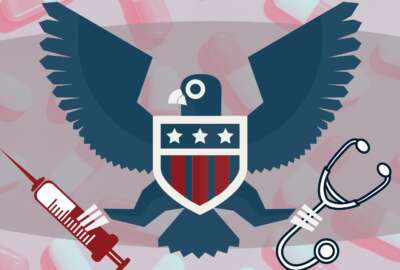

Before health premium rates increase by an average of 8.7% in 2023, some health care experts tell FEHB enrollees to double-check their plans during open season,...
Health premium rates rise virtually every year under the Federal Employee Health Benefits Program, but for 2023, the year-to-year increase is higher than it has been in over a decade.
As a result, it’s particularly important for FEHB enrollees to check their health care plan selections, look at other options and evaluate what meets their needs at the lowest cost, said John Hatton, National Active and Retired Federal Employees (NARFE) Association’s staff vice president for policy and programs.
On average, federal employees and retirees enrolled in FEHBP will pay 8.7% more toward their health care premiums in 2023. The government’s share of cost increases comes out to 6.6%, creating an average rate increase of 7.2% between the two, the Office of Personnel Management announced on Sept. 30. OPM calculates the premium rates for FEHBP each year based on how much federal employees and retirees used health care during the prior year.
Walton Francis, a health policy analyst and author of the annual Consumers’ Checkbook for federal employees and retirees, told Federal News Network that the higher rates aren’t necessarily surprising given the current inflation levels.
“[The higher rates] may be an exclamation mark, in the sense of the need to make careful plan selection choices,” he said.
One major contributor to the increase in premium rates for 2023, OPM said, was how much participants were using their benefits. During the early part of the COVID-19 pandemic, many FEHB participants visited doctors less frequently for non-urgent care. Now, more than two years past the start of the pandemic, more participants are using their benefits more often, so the associated costs have gone up.
Despite the sharp increase, the premium rates are generally on par with larger private sector health care providers, though they’re slightly higher for FEHBP.
Compared with the overall 7.2% premium rate increase for FEHBP, CalPERS, which purchases health benefits for California state government employees, said its rates would increase 6.75% overall for 2023. Similarly, Aon estimates that health costs could increase by approximately 6.5% next year. Kaiser Family Foundation individual marketplace premiums will rise roughly 10% in 2023.
Participants can make changes to their plan selections during the upcoming open season, which runs Nov. 14 through Dec. 12. Any changes will take effect in the upcoming plan year, which begins on Jan. 1. During open season, participants can also make pre-tax contributions to health care costs, such as flexible spending account contributions.
Anyone enrolled in FEHBP can make health care changes during open season, but usually just about 5% of participants actually take advantage of the opportunity. If participants do make changes, though, they could potentially save up to $2,000 annually in health care premium costs, Francis said.
The amount of savings depend on the plan, but there are several options that some participants aren’t looking at enough, Francis added. Those include high-deductible plans with health savings accounts, and plans that reimburse part or all of a Medicare part B premium.
Retirees who are 65 and older qualify for Medicare, and about 70% of federal retirees enroll in Medicare part B, according to Consumers’ Checkbook.
The Medicare part B reimbursement options under FEHBP plans typically expand a little bit each year, Francis said. For 2023, OPM announced that there are seven plan options that will offer Medicare part B reimbursement for individuals who also enroll in the carrier’s Medicare Advantage Plan.
And enrollees in some plans may end up paying even more than the overall 8.7% average.
For example, the basic and standard plan options offered by Blue Cross and Blue Shield, some of the most popular plans for FEHB enrollees, will go up more than the average premium increase for 2023. The only exception is the BCBS basic plan’s self-only option, which will have a premium increase slightly lower than the overall average.
2023 Enrollee Costs for Blue Cross and Blue Shield Service Benefit Plan Options
| Plan Type | 2023 biweekly cost to enrollees | 2023 biweekly dollar increase for enrollees | 2023 percentage increase for enrollees |
| Basic self | $86.67 | $6.49 | 8.09% |
| Basic self and family | $237.91 | $25.62 | 12.07% |
| Basic self plus one | $217.90 | $21.77 | 11.10% |
| Standard self | $142.40 | $14.93 | 11.71% |
| Standard self and family | $347.89 | $33.78 | 10.75% |
| Standard self plus one | $318.85 | $29.24 | 10.10% |
Data from the Office of Personnel Management, chart by Federal News Network.
Some plans work better for specific participants, depending on their circumstances. For example, Hatton told Federal News Network if a participant lives abroad, there are a couple different plans that are tailored toward that. If participants are younger and relatively healthy, they may want to consider a high-deductible plan — these plans are cheaper, but have more risk. And if a participant has a specific health condition, they’ll want to ensure the plan they choose covers that condition.
“The plan you are in may be one of the ones that goes up more than average, or maybe one of the ones that goes up less than average,” Francis said. “Depending on which way it goes, you may want to congratulate yourself on being in a good plan. Or you may want to say, ‘I really need to switch plans this fall for next year.’”
Full plan brochures will soon be available to view on OPM’s website, in the weeks leading up to the start of open season on Nov. 14.
Copyright © 2024 Federal News Network. All rights reserved. This website is not intended for users located within the European Economic Area.
Drew Friedman is a workforce, pay and benefits reporter for Federal News Network.
Follow @dfriedmanWFED

